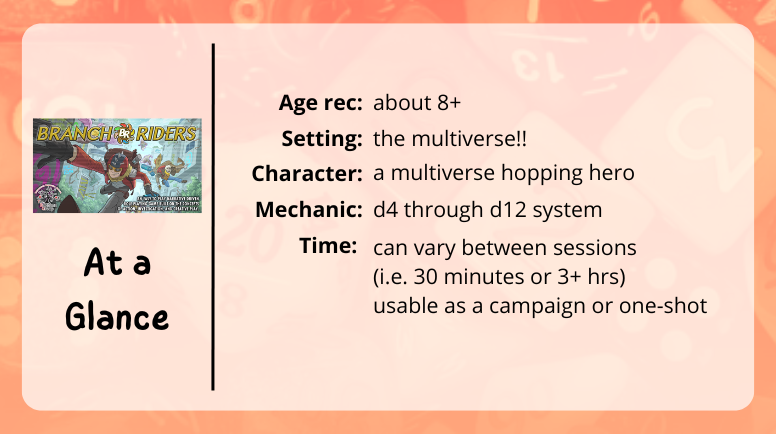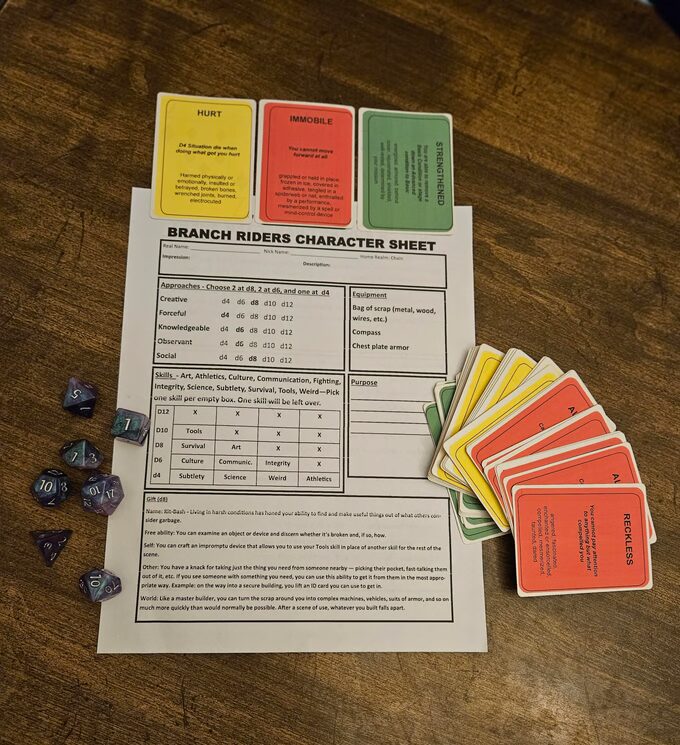Review of The Bodhana Group’s Branch Riders!
Note: this review is based off of a demo copy for a project that is currently in crowdfunding, so the final game may have some differences from the content and images shown in the review.
Jump to:

Branch Riders seems great for all ages, some reading and math required (about 4th grade US level)

Content in Branch Riders is flexible with options for lots of settings and ways to resolve problems. You’ll be determining much of the story and can moderate content to fit you and your players’ needs.
Combat can be part of the game, but action resolution options are spread amongst many skills, meaning that the game may tend to go down a less combat-focused track or will at least give alternative game options. The game also promotes more of a story-telling kind of vibe, so play leans more towards the narrative and less towards mechanics crunch, which may be more accessible to some players.
Math skills focus on addition of up to three dice with the largest being a d12, and there is a small amount of reading required for your character’s special moves. This lines up with about a 4th grade US level for accessibility.
Settings in Branch Riders span the multiverse
Branch Riders takes place across mutltiple dimensions with your team jumping between realms and resolving issues where one time and space may have bled into another… or someone may be up to something between the planes.
This means that you can introduce any genre to the story and player characters can also be from any genre… and it still makes sense.
During the playthrough that I did at Origins Game Fair where I tried this out, I could not stop thinking about the scene in Into the Spiderverse where Miles meets all the other spider-folks. You could totally recreate that scene here, and it would fit the narrative and system wonderfully.

Your character in Branch Riders can be anyone!
As I said in the setting section, this game spans across the whole multiverse, and you’re part of a team comprised of individuals from many planes! This means you can be anyone!
You could be a wizard or a steampunk inventor or a space explorer or a magical fairy cat person… and the rest of your team can be just as varied.
And it fits the system.
Character creation focuses on assigning dice to how you approach a problem and a core set of skills (that are the same for all but that you get to arrange as you want) for event resolutions, so there’s not a bunch of class or job specific criteria that would create a set list of character options to choose from. This was really easy to set up too – I love a good chart, and the approaches and skills all fit into two nice charts where you can clearly see which die to roll for each:

To help each character also have some particularly unique flair and personality, there is the Gift section of the character sheet as well. This is a set of special moves that are unique to that character and can come from the options provided in the game or can be made on your own to fit your creation. This Gift set (that has a move for personal impact, local impact, global impact, etc) can effectively represent your spell list or your natural charismatic talents or your magical fix-it-all tool’s capabilities in a concise way. It’s there as a special move set that can have a bit bigger impact and let your character shine or use some personal strategy while only requiring players to remember a very short list of 1-3 sentence moves.
Mechanics in Branch Riders
Impacting the multiverse and group accountability
Throughout the game, you’ll make success checks using your chosen approach method, skill, and a die from the exposure tracker:

This exposure tracker will change, reducing your exposure die, as your whole group (or whatever you’re trying to fix) has more and more impact to the dimension that you’re in. As you mess with the multiverse more, it gets harder to make successful moves AND it’s a great way to keep the team accountable to each other since this impacts all players mechanically (for those who tend to lean more into the numbers) in addition to impacting the general story (for those who lean more into the narrative).
Condition cards give active visiblity for group tracking and support
At the top of your character sheet, there is also a section for placing your condition cards. These easily and clearly tell you what bonuses you have and the level to which your character is damaged or incapacitated:

image from Branch Riders Kickstarter page
This makes for really easy condition tracking, and, because it is placed on your character page on the table, it is really easy for the other players to actively see how everyone is doing and be able to help each other out without having to break from the game to ask the player their character’s condition.
It’s kind of like… if a superhero shielded a pedestrian from rubble by taking the hit herself, she would have probably incurred some visible damage in the story, so that will show with the “hurt” card. The card tells you, the player, exactly what her condition is without you having to look it up, and other players can see that she has a yellow condition (mildly injured/impacted) just like the team of superheroes would be able to see each other taking damage in a situation.
This also really clearly tracks “health” in a more meaningful way. Instead of it being numbers that you’re tracking, you’re watching how many red cards you have at any time (too many, and you can’t do much to help), and the damage isn’t just numbers, it’s conditions, like not being able to move forward or reducing the die you can roll. It assists the narrative and encourages the team to support each other and strategize how they’ll keep everyone safe.
Overall thoughts on Branch Riders
I thought Branch Riders was a wonderful game, and I loved the options that this gives to both players and facilitators to create a narrative that really connects with everyone’s particular interests (i.e. you can easily have a dinosaur dimension, a superhero dimension, and a magical cats dimension all in the same story to fit varied player connections). It was easy to understand gameplay with a few minutes of review, and it provides many tools, like cards, charts, and trackers, to help take some of the mental load of the game from memorization and putting it towards actually using the mechanics, creating a story, and interacting with each other. I’m looking forward to the Kickstarter to continue its success, and I hope you get the opportunity to check the game out yourself!
Find a copy of Branch Riders
You can find Branch Riders on Kickstarter to pre-order a copy until July 10, which supports the project and achieving stretch goal rewards. Afterwards, it looks like it will be available through DriveThruRPG, and I’ll add the link here when it’s ready.
You can also find out more about The Bodhana Group by checking out their website here and checking out my interview with their founder, Jack, on TTRPGkids!

If you liked this post, make sure to subscribe to the TTRPGkids monthly newsletter to stay up to date on the latest reviews, tips and tricks, game and podcast list updates, and more! Thank you for playing tabletop RPGs with your kids and sharing this awesome hobby with the next generation!


